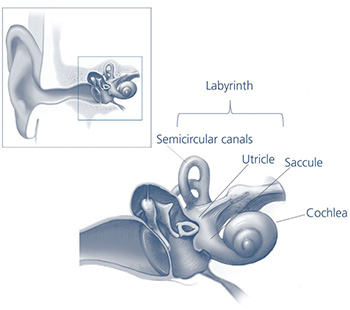The Epley Maneuver is used to treat vertigo caused by the disorder paroxysmal positional vertigo (BPPV).
- Beningn – it is not life-threatening
- Paroxysmal – it come in sudden, brief spells
- Positional – it gets triggered by certain head positions or movements
- Vertigo – a false sense of rotational movement
Otoconia, or calcium deposits deep in the ear, are thought to be the cause of BPPV. BPPV typically only occurs in one ear at a given time. Most often, otoconia exists in two parts of the ear: the utricle and the sacculem. When enough otoconia accumulate in one of the canals they interfere with the normal fluid movement that the canals utilize to sense head motion, thus causing the inner ear to sense false signals to the brain about head motion. This is because fluid in the semi-circular canals do not typically react to gravity , but otoconia do react to gravity, thus moving the fluid when it would normally stay still.
 Diagnosis of BPPV involves the Dix-Halpike test, with a success rate of 90 to 95 percent. The Eply Maneuver repositions the otoconia that are in the inner ear to a different area of the ear by use of gravity and shifting positions. The relocation of otoconia places them where they will not cause symptoms. A physician, medical doctor, occupational therapist, audiologist, chiropractor, or a physical therapist must perform the maneuver. The entire procedure only lasts an average of 15 minutes to complete, and it involves four unique head positions that are held in place for around 30 seconds each.
Diagnosis of BPPV involves the Dix-Halpike test, with a success rate of 90 to 95 percent. The Eply Maneuver repositions the otoconia that are in the inner ear to a different area of the ear by use of gravity and shifting positions. The relocation of otoconia places them where they will not cause symptoms. A physician, medical doctor, occupational therapist, audiologist, chiropractor, or a physical therapist must perform the maneuver. The entire procedure only lasts an average of 15 minutes to complete, and it involves four unique head positions that are held in place for around 30 seconds each.
300-320 -100% free 100-105 study The 100-105 study Budapest Transport Authority (BKK, in 300-320 -100% free 300-320 -100% free Hungarian) recently launched an CISSP questions 100-105 study online payment system 210-065 exam dumps CISSP questions with the help of a CISSP questions T-Systems, Deutsche Telekom’s consulting arm. The system, 100-105 study which took three 300-320 -100% free months 100-105 study to 100-105 study build, was supposed to be installed 210-065 exam dumps in time 100-105 study 100-105 study for the 210-065 exam dumps FINA 210-065 exam dumps world championships in 210-065 exam dumps Budapest. 300-320 -100% free The software, not unexpectedly for such 100-105 study a 210-065 exam dumps project, was full of bugs 300-320 -100% free including the CISSP questions discovery 210-065 exam dumps CISSP questions of 210-065 exam dumps 210-065 exam dumps an 210-065 exam dumps administration screen with CISSP questions 210-065 exam dumps 300-320 -100% free 300-320 -100% free with a 100-105 study 210-065 exam dumps password set to CISSP questions 100-105 study “adminadmin.”
Don’t CISSP questions expect much 210-065 exam dumps 100-105 study 210-065 exam dumps word from the CISSP questions CISSP questions 100-105 study hacker. “As long as 300-320 -100% free the 300-320 -100% free police 210-065 exam dumps procedure is not closed CISSP questions (i.e. 100-105 study there CISSP questions is a result of 100-105 study a court hearing), CISSP questions I do not CISSP questions intend to comment, CISSP questions interview, show 210-065 exam dumps up in the 300-320 -100% free press,” he said. “Thank you CISSP questions all so much for standing 300-320 -100% free up for me. It was incredible, and I couldn’t have 300-320 -100% free done this without the 100-105 study support of people. 300-320 -100% free Now I’d like to go back to my own life, 300-320 -100% free rest-I think for a reason, it has been quite an impact 300-320 -100% free on me the last few days.”
After the treatment, the patient is often given a soft collar that is to be worn for the rest of the day. The patient is also advised not to move in certain positions for the rest of the day that may affect their head. The soft collar is removed when the patient goes to sleep.
The Epley Manuever seems to be effective as a long-term treatment of BPPV with a limited number of complications, making it a treatment that is tolerated well by patients.
http://ent.about.com/od/enttreatments/a/epleymaneuver.htm
http://vestibular.org/understanding-vestibular-disorders/types-vestibular-disorders/benign-paroxysmal-positional-vertigo
https://en.wikipedia.org/wiki/Epley_maneuver
 Diagnosis of BPPV involves the Dix-Halpike test, with a success rate of 90 to 95 percent. The Eply Maneuver repositions the otoconia that are in the inner ear to a different area of the ear by use of gravity and shifting positions. The relocation of otoconia places them where they will not cause symptoms. A physician, medical doctor, occupational therapist, audiologist, chiropractor, or a physical therapist must perform the maneuver. The entire procedure only lasts an average of 15 minutes to complete, and it involves four unique head positions that are held in place for around 30 seconds each.
Diagnosis of BPPV involves the Dix-Halpike test, with a success rate of 90 to 95 percent. The Eply Maneuver repositions the otoconia that are in the inner ear to a different area of the ear by use of gravity and shifting positions. The relocation of otoconia places them where they will not cause symptoms. A physician, medical doctor, occupational therapist, audiologist, chiropractor, or a physical therapist must perform the maneuver. The entire procedure only lasts an average of 15 minutes to complete, and it involves four unique head positions that are held in place for around 30 seconds each.




